
www.homelegend.com
DOC: HWH-V001 – 8/2017
1 | Page
Installation Guide:
Solid Bamboo Flooring
For questions or concerns please contact our technical support
Monday – Friday 7:00 a.m. – 4:00 p.m. PST
1-877-630-1800 – option 2
For the latest version of installation instructions visit
www.homelegend.com

www.homelegend.com
2 | Page
DOC: HWH-V001 – 8/2017
Safety Information .............................................................................................................3
Wood Dust...................................................................................................................
Asbestos in existing floors...........................................................................................
Product Certifications .......................................................................................................3
Greenguard Gold Certification....................................................................................
Product Specification .........................................................................................................4
Pre-Installation ............................................................................................................... 5-9
Safety and Health Precautions ....................................................................................5
Owner/installer responsibility .....................................................................................5
Inspection ....................................................................................................................5
Prior to installation ......................................................................................................5
Tools and Materials .....................................................................................................5
In-service Conditions ..................................................................................................6
Storage and Condition .................................................................................................6
New Construction or Remodel ....................................................................................6
Existing Home ............................................................................................................6
Basements and Crawl Spaces ..................................................................................... 6
Concrete Subfloor Requirements ................................................................................7
Light Weight Concrete ................................................................................................7
Concrete Moisture .......................................................................................................7
Wood Subfloor Requirements .....................................................................................7
Particle Board or Fiber Board .....................................................................................7
Existing Floors ............................................................................................................7
Moisture Barrier and Moisture Retarder .....................................................................8
Sound Control Underlayment ..................................................................................... 8
Expansion Gap ............................................................................................................ 8
Transition Molding ..................................................................................................... 8
Radiant Heated Subfloor ............................................................................................. 8
Adhesive ..................................................................................................................... 8
Bond Failure................................................................................................................ 8
Glue Spots on Face of Finished Floor ......................................................................... 8
General Tips ..................................................................................................................... ...9
Pre-Install Activities ........................................................................................................ 10
Glue Down Installation ............................................................................................... 11-12
Accessories ........................................................................................................................ 13
Care and Maintenance .................................................................................................... 14
Warranty .......................................................................................................................... 15
TABLE OF CONTENTS

www.homelegend.com
3 | Page
DOC: HWH-V001 – 8/2017
Safety Information
CAUTION: WOOD DUST
Sawing, sanding and machining wood products can produce wood dust. It can cause respiratory, skin and eye
irritation. Avoid prolonged exposure to wood dust. Power tools should be equipped with a dust collector. It is
recommended to perform wood dust generating activities outdoors. If high dust levels are encountered use an
appropriate NIOSH-designated dust mask.
CAUTION: ASBESTOS IN EXISTING FLOOR
This Home Legend product does not contain asbestos. Existing installed resilient flooring and asphaltic adhesive may contain
asbestos fillers or crystalline silica. Do not sand, dry sweep, dry scrape, drill, saw, bead-blast, or mechanically chip or pulverize
existing resilient flooring, backing, lining felt, asphaltic “cutback” adhesive or other adhesive. See “Recommended Work
Practices for Removal of Resilient Floor Coverings” (rfci.com) for detailed information and instructions on removing all
resilient covering structures.
GREENGUARD CERTIFICATION
Home Legend Solid Bamboo Flooring is Green Guard Gold Certified. The GREENGUARD Gold Certification requirements comply with
the State of California’s Department of Public Health Services Standard Practice for Specification Section 01350 (California Section
01350) for testing chemical emissions from building products used in schools and other environments. As such, GREENGUARD Gold
Certified products can be used to earn valuable credits in the CHPS Best Practices Manual for K-12 schools, the US Green Building
Council's LEED® Green Building Rating Systems, the Green Guide for Healthcare, the NAHB Green Building Guidelines, Green
Globes, Regreen and many other building codes, standards and specifications. For more information, visit www.ul.com/gg or
www.greenguard.org

www.homelegend.com
4 | Page
DOC: HWH-V001 – 8/2017
Product Included
Approved Installation Methods
Approved grade levels
All Bamboo Tongue
And Groove
Primary Method: Full
Spread Glue
Above Grade.
On Grade.
Product Specifications
Wear layer:
The top coat film is a polyurethane sealer with an aluminum oxide finish; which improves scratch resistance. The polyurethane layer is UV
cured.
Solid Plank:
Solid bamboo flooring consists of bamboo strips pressed together to create a solid plank with a t tongue and groove joint system. Flooring
can only be glued on the subfloor as a traditional installation method. A moisture retardant wax seal is added to the structure of each plank
to improve moisture protection. This solid construction allows the flooring to be sanded and refinished.

www.homelegend.com
5 | Page
DOC: HWH-V001 – 8/2017
Tools and Materials:
✓ Tape measure
✓ Moisture meter (wood, concrete or
both)
✓ Chalk line & chalk
✓ Hammer
✓ Power saw
✓ Pull bar
✓ Flooring adhesive or Joint Glue
✓ Trowels
✓ Carbide tipped saw blade for fine
cut
✓ NIOSH-designated dust mask
✓ Hand saw or jamb saw
✓ Tapping block
✓ Adhesive remover for selected
adhesive
✓ Clean rags
✓ Eye protection
✓ Straight edge
✓ Pry Bar
✓ Mallet
✓ Broom
✓ Color matched wood putty
✓ Weight roller
✓ Painters Tape
Pre-Installation
Safety and health precautions:
✓ Power tools can be dangerous. Operate in strict accordance with the manufacturer’s operating instructions and safety precautions.
✓ Unsafe and improper use can cause serious injuries.
✓ Avoid inhalation and exposures to wood dust, by mechanical means, by wearing personal protective equipment.
✓ Wear appropriate personal protective equipment (PPE) which includes NIOSH or OSHA approved dust masks, safety goggles
and work
gloves.
Owner/Installer Responsibility:
• Be advised, the owner is to be present during the installation for consultation/direction.
• The owner and installer should discuss installation and arrangement to maximize satisfaction. If this is not possible, consultation should
be done prior to installation.
• The manufacturer’s installation guide is the primary source of installation procedures. Installers should also be familiar with installation
guidelines from National Wood Flooring Association (NWFA) woodfloors.org.
• The owner/installer accepts all responsibility for product quality of completed installation.
• Flooring to be installed in one large area should be purchased at the same time. Product purchased at a later time than the first purchase
may vary.
Inspection:
• Arrange planks from several boxes to ensure even distribution of color, shade and/or characteristics.
• Wood floors are natural products containing natural variations.
• Variations in color, tone, grain, mineral streaks, small knots and other characteristics can be found from plank to plank.
• Similar variations exist between samples, images and the purchased flooring. This is normal and it does not mean the
product is defective.
• For claims purposes, you are allowed to open up to 4 boxes for product inspection.
IMPORTANT: Do not open all the boxes, opening all the boxes constitutes your acceptance of the product.
• Examine flooring for product quality and customer satisfaction.
• If the customer is satisfied, proceed with installation.
• If the customer discovers that the product is defective, or if material is questionable, you should stop the installation
and contact the retailer.
• This product is manufactured according to strict industry quality standards. Standards permit a defect tolerance not to exceed 5%.
• Order an additional 5% extra for cutting wastage and grading allowances (10% for diagonal installations).
• During installation, inspect the planks continuously. Defects that can be seen from a standing position should be cut off or removed.
Installing defective planks implies acceptance.
Note: Accessories, trims and moldings are manufactured to coordinate with the varied appearances of the floor planks; any exact matches are
coincidental. Non-matching accessories are not defective products.
Prior to installation:
• Arrange planks from several boxes to ensure even distribution of color, shade and/or characteristics.
• Ensure subfloor is clear of debris and dirt.
• The length of the each plank in any box can vary from 12 inches to the maximum full length stated on the packaging or other product
descriptions. Each box can contain all full length boards or a combination of full length and shorter boards. There is no specific
percentage of product length distribution.

Acclimation In-service Conditions:
Acclimation is the process of adjusting (conditioning) the moisture content of bamboo flooring to the environment in which it is expected to perform.
The bamboo flooring is fully acclimated when its moisture content and dimensions (width and length) are stable for at least 3 consecutive days.
Allow at least 72 hours for bamboo to acclimate to the temperature and humidity of the room. If flooring is being installed in an excessively dry or
humid climate, allow additional acclimation time. Cut open the boxes and plastic wrap of the packaging to allow air circulation. Elevate planks from
the floor by placing them on 4”X 4” lumber or equivalence. Place spacers (3/4” to 1” sticks) between each layer and cross stack the layers for
maximum exposure to ambient conditions. Acclimation Installation temperature range is 60°F-80°F and relative humidity (RH) of 35%-55%.
Conditions in which the floor was acclimated installed should be maintained continuously thereafter. It is recommended to document acclimation
information below:
Date: _
Relative Humidity (%):
Temperature (°F):
Subfloor Type:
Subfloor Avg. Moisture Content (%):
Flooring Avg. Moisture Content (%):
Job Site Condition
• At the time of installation, the installer must ensure that the job site conditions will not negatively affect floor.
• Conditions include: subfloor/substrate, ambient temperature and relative humidity, and all other impacting variables.
• Manufacturer will decline responsibility for damages associated with improper installation or poor site conditions.
Storage and Condition
• Do not store flooring in uncontrolled environmental conditions.
• Garages and exterior patios are not acceptable areas to store flooring.
• Handle and unload wood flooring with care and store within the environmentally controlled site in which it is expected to
perform.
• Flooring stored on concrete slab should be elevated at least four inches to allow air circulation under cartons.
New Construction or Remodel
• All work involving water, such as pouring basement concrete floors, drywall and plasterwork, plumbing, etc. must be
completed well in advance of the floor delivery.
• Ensure that the building is enclosed.
• Where building codes allow, permanent heating and/or air conditioning systems should be operating at least five days
preceding installation.
• Consistent temperature of 60°F-80°F and relative humidity (RH) of 35%-55% which should be maintained continuously
thereafter.
Existing Home
• Existing home should have a consistent room temperature of 60°F-80°F and relative humidity (RH) of 35%-55%.
• Continuous deviation from the specified conditions will affect the dimensions of flooring.
• During heating season, humidity may be much lower than the acceptable range. Throughout heating season, a humidifier is
recommended to prevent excess shrinkage.
• During the non-heating season, humidity levels can be maintained by using an air conditioner, dehumidifier, or by turning
on your heating system periodically.
Basements and Crawl Spaces
• Concrete slab or surface must be dry.
• The surface in the crawl spaces must be completely covered using 6 mil black polyethylene.
• Crawl space clearance between the earth and underside of joists should be no less than 18 inches.
• Perimeter vent area should be equal to 1.5% of the total square footage of the crawl space or as mandated by code.
www.homelegend.com DOC: HWH-V001 6 | Page
Pre-Installation (cont’d)

www.homelegend.com
DOC: HWH-V001
7 | Page
Concrete Subfloor Requirements
•
It must have minimum rated strength of 3000 psi.
•
It must be flat. It should be flat within 1/8” in a 6-foot span
or 3/16” in a 10 foot span; no bumps or low spots. High
spots can be removed by grinding; depressions can be filled
with patching compound formulated for use in floor
installation.
•
It must be clean; no construction debris, soil, mud and any
other objects on/or adhering to the floor; if necessary, scrape
and sweep away before the installation; no protrusions of
nails, debris, metals should remain.
•
New concrete slab must cure for at least 60 days.
•
It must meet concrete moisture mentioned below.
•
It must be free from moisture related conditions which can
damage the installed flooring.
Light Weight Concrete
It is concrete with a rated strength of less than 3000 psi.
Perform a quick check by drawing a nail across the top; if it leaves
indentation, it is light concrete.
For glue-down application, the concrete must possess shear strength
greater than the glue. If concrete rated psi is unknown, contact the
adhesive manufacturer for guidance.
Concrete Moisture
All concrete subfloors should be tested for moisture content and
results should be documented, Visual checks are not reliable.
Perform tests at locations around exterior doorways, near walls
containing plumbing, near foundation walls and in the center of the
room. Perform three tests for the first 1,000 sq. ft. and one test for
every additional 1,000 sq. ft. thereafter. The concrete moisture
content should meet one of the following criteria below:
•
4.5% when tested using Tramex Concrete Moisture
Encounter
•
Less than 3 pounds per 1000 square feet per 24 hours when
using Calcium Chloride test (ASTM F 1869)
•
75% when using Relative Humidity Testing (ASTM F-2170).
Please note: Concrete moisture content may be acceptable the time
of the test but these tests do not guarantee a perpetual “dry”
concrete slab. The concrete slab moisture content can vary at other
times of the year. We are not responsible for moisture related
damage to installed flooring.
Wood Subfloor Requirements:
•
It must be clean; no presence of construction debris, soil,
mud and any other objects on or adhering to the floor; no
protrusions of nails, debris, metals should remain. If
necessary, scrape and sweep the subfloor before the
installation.
•
It must be structurally sound and stable: no movements or
squeaks, no loose panels or loose nails, no signs of ply de-
lamination or other damages. Repair all shortcomings before
installation.
•
It must be flat with no bumps or low spots; the subfloor
should be flat within 1/8” in 6 feet span or 3/16” in 10 feet.
•
Test for moisture using reliable moisture meter. Perform
tests at locations around exterior doorways, near foundation
walls, near walls containing plumbing lines and in the center
of the room. Measure 20 locations per 1000 square feet.
•
Moisture content of subfloor should be less than 12%.
Plywood or Oriented Strand Board (OSB) Specifications
•
On truss/joist spacing of 16” (406mm) O/C or less, the
industry standard for single-panel subflooring is minimum
5/8” (19/32”, 15.1 mm) CD Exposure 1 plywood subfloor
panels (CD Exposure 1) or 23/32” OSB Exposure 1 subfloor
panels, 4’ x 8' sheets. Expansion gap between panels should
be 1/8” (3 mm). If panels are not tongued and grooved and
there is not sufficient spacing or is inadequate, cut in the
required spacing with a circular saw. Do not cut in expansion
space on tongue and groove panels.
Existing Floors
Installation over existing floor requires the installer to consider
potential issues related to moisture damage, adhesive failure and
fastener failure. Contact the adhesive and fastener manufacturers
respectively for their specific instructions, recommendations and
requirements.
• Acceptable floor coverings include: solid hardwood,
linoleum, terrazzo, ceramic tile and other “moisture
sealed floors.”
• Unacceptable floor coverings include: floating floors,
carpet, needle punch felt, edge glued linoleum and other
“moisture absorbing flooring.”
Pre-Installation (cont’d)

www.homelegend.com
DOC: HWH-V001
8 | Page
Expansion Gap
• Required gap width is 3/4”.
• It is required around the perimeter of the floor and between floor and all vertical obstructions.
• Do not place permanently installed structures such as kitchen counter/cabinet on the installed floor.
• Cutting around permanent structures will save square footage and waste.
Radiant Heated Subfloor
• This solid product cannot be installed over radiant heated subfloor.
Adhesive
• Use a non-water base premium flooring adhesive, formulated for solid bamboo flooring installation.
• Preferred type: moisture cure urethane floor glue.
Bond Failure
Bond failure is not flooring product defect. Most installation failures, including bond failure, result from jobsite moisture. Do not unpack or
deliver flooring to the jobsite until moisture problems are corrected. Read adhesive manufacturer’s instruction carefully. Certain wood flooring
adhesives may have special requirements and limitations of use. Some existing floor may not be acceptable. Not following the adhesive
manufacturer’s recommendations can lead to installation failure or product damage and will void your warranty.
Glue Spots on Face of Finished Floor
Adhesive can damage the floor’s finish, especially when it has dried. It is extremely important to take precautionary steps NOT to leave finger
prints or footprints marks on the face of the board. If glue comes in contact with the face of the board, remove immediately with the adhesive
remover recommended by the adhesive manufacturer. Use clean towels, changing them frequently to prevent haze and adhesive residue. If
the spot removal damages the appearance of the boards, replace the board.
Pre-Installation (cont’d)

www.homelegend.com
DOC: HWH-V001
9 | Page
Helpful Pointers
General Tips
• Make sure your work area is well lit. Good visibility ensures that color is consistent and that visually defective planks
are detected and removed.
• The remainder of the last plank can be used as a starter board on the following rows. The minimum length of the
first and last plank needs to be longer then the width of the material being installed.
• Leave 3/4” expansion gap around perimeters, under doors and around vertical objects, including permanent or
fixed cabinetry.
• Using a shorter piece at undercut door jams will help when fitting flooring in place.
• Most often the entire length of the last row will need to be cut so that it is narrow enough to fit the remaining
space.
Glue-Down Installation Tips
• Always refer to the specific instructions on the flooring adhesive label. The information given here is for typical
installation. Adjust it according to adhesive manufacturer’s instruction.
• Use trowel as specified by adhesive manufacturer.
• Continuously check the transfer of adhesive THROUGHOUT the installation process. If the adhesive no longer
transfers to the back of the flooring material, it must be removed and new adhesive applied.
• Work your way out of the room.
• After the installation is completed, keep the floor free from daily foot traffic for a minimum of 24 hours to allow
adhesive to properly cure.
General Tips

www.homelegend.com
DOC: HWH-V001
10 | Page
Pre-install Activities
•
Subfloor should be in a clean condition.
•
Inspect plank quality and grading.
•
Lay out several cartons.
•
Arrange planks to ensure even color distribution.
•
A random pattern is recommended.
•
Minimum stagger point should be longer then the width of the plank.
.
•
Remove existing base, shoe molding or threshold carefully. They can be used to cover the 3/4” expansion gap left around the
edge of the room.
•
Undercut doors and casings using a handsaw laid flat on a piece of scrap flooring. This eliminates difficult scribe cuts.
•
Always use protective foot/pad and proper height adapter plate on the fastening machine to prevent face damage, mallet
damage, and edge bruising.
Pre-install Activities

www.homelegend.com
DOC: HWH-V001
11 | Page
Step 1 – Establish a Starng Line
Step 2 – Spreading the Glue
a.) Spread the glue from the straight edge / chalk line out
towards the direcon of the starng wall. Spread only
enough glue to install what can be set within 45 minutes
(15 minutes of OPEN TIME and an addional 30 minutes
for actual installaon). Usually about two rows width
coverage. Different manufacturer may require different
open me and set me.
b.) You will repeat step 2a with each succeeding row.
Glue Down Installation
PLEASE NOTE:
ANY EXCESS GLUE WHICH GETS ONTO THE SURFACE OF THE FLOOR MUST BE REMOVED IMMEDIATELY WITH ADHESIVE
REMOVER
a) Select a straight starter wall.
b) Lay out the direcon of the floor. If possible, install the
flooring perpendicular to the joists.
c) Mark the starng line using a chalk line. This distance between
the wall and the line should equal the face width of 2 floor
planks plus 3/4” (create expansion gap by leaving ½” space
between wall and cung off the ¼” tongue from the long side
of the plank).
d) Securing a straight edge on the side away from the starng
wall is recommended to ensure straight alignment of the
starter rows
Step 3 – Install the Starter Rows (first two rows)
a.) Installaon begins from the straight edge / chalk line
out with tongue facing away from the wall.
b.) Allow expansion gap between the wall and the end
of the board.
c.) Use a 75-pound roller to roll the flooring
immediately aer 150 square feet.
d.) Remove straight edge and connue with the
installaon.
2a

www.homelegend.com
DOC: HWH-V001
12 | Page
Glue Down Installation
Finishing Touches
Clean the floor.
Install or reinstall all wall trim pieces. Nail them through the wall, but not to the subfloor to avoid restricng the expansion gap.
Step 4 – Install the Remaining Rows
a) Spread another secon of glue. Never spread more that
can be covered before the adhesive is set. If adhesive is set
and will not transfer to the back of the plank, scrape off
the adhesive and apply fresh adhesive.
b) Connue to install the next rows.
c) Make sure there is a random staggering at the end
joints of at least 6” apart. Be aenve to staggering the
ends of the boards correctly in adjacent rows to avoid
clustering end joints.
d) Ensure that a 3/4” expansion gap is maintained around the
pe
rimeter of the room.
e) Make sure that there is 100% adhesive contact between
the underside of the planks and subfloor. Any excess
glue which seeps onto the surface of the floor must be
removed immediately with adhesive remover. Do not
apply on T&G edge.
f) Tap the planks together unl the tongue and groove
are in place. Be careful NOT to damage the face of the
planks. Use a clean, smooth, 75-pound roller to roll the
flooring immediately aer installaon and aer every
150-square foot interval during the installaon to
insure proper adhesive transfer.
g) The Pull Bar helps you reduce seams in ght spaces, that
can't be reached with a tapping block while the glue dries.
h) The flooring should be taped together during installaon
using painters tape to keep the planks from moving during
installaon while the glue dries. The tape must be le in
place for a minimum of 24 hours.
i) Aer the installaon is completed, keep the floor free
from foot traffic for a mini
mum of 24 hours to allow
adhesive to properly set.
4a4a 4b 4c
4d
4e
4f 4g 4h

www.homelegend.com
DOC: HWH-V001
13 | Page
Diagrams are for general illustra ve purposes only. Actual products may differ from picture.
T-Molding is used to create a transi on between floor coverings of similar
heights.
Stair Nose is used in conjunc on with flooring installed on stair steps or
finished edge of a higher-level floor like in a sunken living room.
Carpet Reducer (also called Baby Threshold or End Cap) is used to transi on
floor coverings of differing heights. This reducer is also commonly used to
border a fireplace, sliding glass door and other exterior door jambs.
Hard Surface Reducer is used to transi on to another hard surface flooring of
different heights such as le, vinyl, concrete.
Wall Base is used to give a finished look at the base of the walls. It can be used
with or without Quarter Round.
Quarter Round is used to cover the expansion space between the Wall Base
and your flooring. It can also be used them to make smooth transi ons
between the floor and cabinetry. It can be used with or without Wall Base
molding.
Accessories
Technical Support
For installa on informa on and technical ques ons not covered in this installa on guide, please contact our Technical Support Representa ve by
calling the toll-free number below.
Toll Free Number: 877-630-1800 or 877-960-8001
T-MOULDING
FLOORING
FLOORING
FLOORING STAIR NOSE
RISER
STAIR TREAD
CARPET REDUCER
FLOORING
CARPET
HARD SURFACE
REDUCER
FLOORING
RESILIENT
FLOOR
WALL
QUARTER ROUND
FLOORING
WALL

www.homelegend.com
DOC: HWH-V001
14 | Page
Daily Maintenance
1. Sweep, dust mop or vacuum your floor regularly to remove any particles that could cause abrasion or scratch your floor.
2. CAUTION: Vacuums with a beater bar or power rotary brush head can damage a floor and should never be used.
3. Use a damp mop to remove spots and soil. Apply appropriate cleaning solution to the cleaning cloth / mop. Do NOT apply directly to the
floor.
•
For lightly soiled area, clean with distilled water.
•
For moderately soiled area, use a mild solution of isopropyl alcohol and distilled water. Isopropyl alcohol is commonly referred to as
rubbing alcohol and is sold in up to 70% concentrations. This product should be diluted by mixing one-part alcohol and 2 parts distilled
water.
•
For tougher spots, use a higher concentration of isopropyl alcohol and distilled water.
•
For extreme cases, acetone and distilled water can be used.
HINT: For best results, clean the floor in the same direction of the planks. When the cleaning cloth/mop becomes soiled, rinse or replace it with a
clean one. Following up with a clean, dry cloth will remove residual streak marks and spots.
4. Do NOT leave any amount of liquids (water, juice, soft drinks, spills, etc.) on the floor. Clean any wet spots immediately.
5. Do NOT use a steam cleaner.
6. Do NOT use a wet mop or douse floor with water or liquid cleaners. Liquid can seep between the cracks and cause moisture damage.
7. Do NOT use any cleaning agents containing wax, oil or polish. Left over residue will form a dull film.
8. Do NOT use steel wool or scouring powder which will scratch the floor.
Cleaning with store bought product
•
If you choose to use a store-bought product, test the product in a non-conspicuous area (i.e., closet, corner, or scrap pieces) for
potential adverse side effects.
Preventative Maintenance
•
When rolling heavy furniture or appliances across the installed floor, a protective sheet and/or plywood may be needed to help from
scratches and or debris.
•
Place protective pads beneath furniture legs and other heavy objects.
•
Minimize abrasive material and dirt by placing mats on both sides of exterior doors and by using area rugs in high-traffic areas.
•
Rearrange furniture and rugs periodically to avoid uneven color and shade changes from light exposure.
•
Use protective mats beneath rolling chairs and keep furniture casters clean.
•
Keep pets’ nails trimmed.
•
Remove shoes with cleats, spikes or exceptionally pointy heels before walking on the floor.
Climate Maintenance
•
Care should be taken to control humidity levels within the 35% - 55% range. Flooring, especially hardwood and bamboo, dimensions will
be affected by varying levels of humidity.
•
Dry Climates: A humidifier is recommended to maintain humidity levels. Wood stoves and electric heat tend to create very dry
conditions during the winter months this also will cause shrinkage in flooring.
•
Humid, Wet Climates: By using an air conditioner, heater, or dehumidifier proper humidity levels can be maintained to prevent excessive
expansion due to high moisture content.
Floor Repair
•
Very light and small surface scratches can be repaired with a staining “touch up” pen of the appropriate color.
•
Slightly deeper scratches can be repaired by means of colored putty and or stains. Fill the scratches with the putty. Level with putty knife.
Wipe off excess putty.
•
Very deep scratches may require the replacement of the planks.
Care and Maintenance

www.homelegend.com
DOC: HWH-V001
15 | Page
WARRANTY REGISTRATION
PLEASE SEND ALL COMPLETED FORMS ALONG WITH A COPY OF PROOF OF PURCHASE TO [email protected] OR SUBMIT
TO THE ADDRESS BELOW:
HOME LEGEND, LLC
WARRANTY REGISTRATION
P.O. BOX 887
ADAIRSVILLE, GA 30103
NOTE: ONLY 1 REGISTRATION FORM IS REQUIRED. PLEASE KEEP A COPY OF RECEIPT FOR YOUR RECORDS.
Customer Name
Customer Address
City, State, ZIP Code
Phone/E-mail
Product Model Number
Product Description
Date Purchase
Retailer Name
Retailer Address
City, State, ZIP Code
Installer
Warranty
Home Legend, LLC flooring comes with Limited Wear Warranty. The limited warranties apply to original purchaser of the flooring and are not
transferable. For detailed terms of coverage and limitations please contact our Customer Service Department by calling our toll-free number: 1-
877-630-1800.
-
 1
1
-
 2
2
-
 3
3
-
 4
4
-
 5
5
-
 6
6
-
 7
7
-
 8
8
-
 9
9
-
 10
10
-
 11
11
-
 12
12
-
 13
13
-
 14
14
-
 15
15
Ask a question and I''ll find the answer in the document
Finding information in a document is now easier with AI
Related papers
-
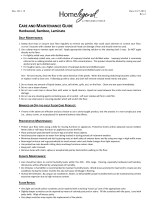 HOMELEGEND HL283S User manual
HOMELEGEND HL283S User manual
-
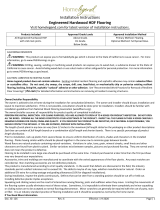 Home Legend HL196H Installation guide
Home Legend HL196H Installation guide
-
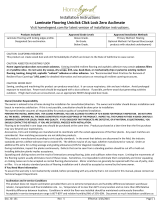 Home Legend HL1257 Installation guide
Home Legend HL1257 Installation guide
-
 Home Legend HL663 Installation guide
Home Legend HL663 Installation guide
-
 Home Legend HL663 User guide
Home Legend HL663 User guide
-
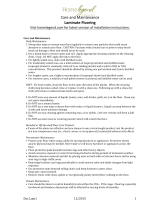 HOMELEGEND HL1220-48 User manual
HOMELEGEND HL1220-48 User manual
-
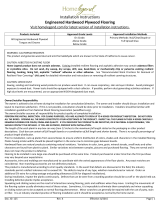 HOMELEGEND HL16P Installation guide
HOMELEGEND HL16P Installation guide
-
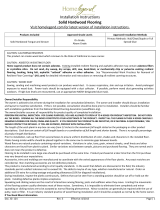 HOMELEGEND HL157S Installation guide
HOMELEGEND HL157S Installation guide
-
 HOMELEGEND HL284P Installation guide
HOMELEGEND HL284P Installation guide
-
HOMELEGEND HL189H Installation guide
Other documents
-
GREENWOOD LOA2496MJA-RH User manual
-
Home Decorators Collection HL618S Installation guide
-
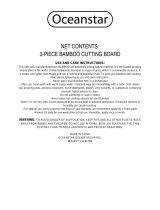 Oceanstar CB1156 User guide
Oceanstar CB1156 User guide
-
 Home Legend HL17 Installation guide
Home Legend HL17 Installation guide
-
Home Decorators Collection AM1318E Installation guide
-
Home Decorators Collection YY3004C Installation guide
-
Home Decorators Collection YY2009GD Installation guide
-
Home Decorators Collection YY3004C Installation guide
-
Home Decorators Collection YY2017AD Installation guide
-
Home Decorators Collection YY3004D Installation guide

























